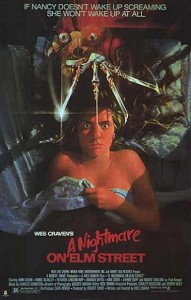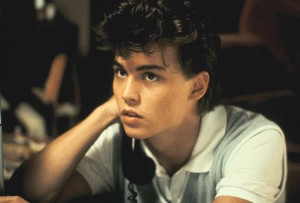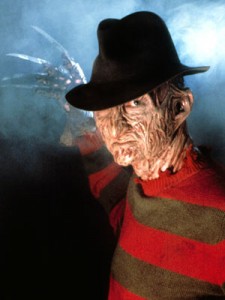Continuing with my flashback to the 1985 UC Theater double-feature, after The Evil Dead came Wes Craven’s iconic entry into ’80s slasher horror, A Nightmare on Elm Street (1984).
 Prior to Nightmare, Wes Craven had written and directed two staples of low budget ’70s horror cinema: The Last House on the Left (1972) and The Hills Have Eyes (1977).
Prior to Nightmare, Wes Craven had written and directed two staples of low budget ’70s horror cinema: The Last House on the Left (1972) and The Hills Have Eyes (1977).
The premise of Nightmare is based on newspaper articles that Craven read in the L.A. Times about Cambodian refugees suffering from disturbing nightmares, who as a result resisted going to sleep. There were also accounts of some of these men actually dying in their sleep, including one who was allegedly screaming as if having a nightmare.
Freddy’s famous red and dark green striped sweater came out of something Craven had read in Scientific American that these two colors were the most difficult for the human eye to put side-by-side.
It’s interesting to note that in Nightmare, there’s a scene with The Evil Dead playing on a television. This was most likely in response to Sam Raimi placing a torn The Hills Have Eyes poster in the background of a scene in The Evil Dead — which was in turn a response to Wes Craven putting a torn Jaws poster in the background of a scene in The Hills Have Eyes. (Raimi had interpreted the inclusion of the torn poster as if to indicate to the audience that as scary as Jaws is, it’s nothing compared to what’s going on in The Hills Have Eyes).
 Casting-wise the film is notable for being the first major film role for Johnny Depp, who plays Glen, the boyfriend of heroine Nancy Thompson (Heather Langenkamp).
Casting-wise the film is notable for being the first major film role for Johnny Depp, who plays Glen, the boyfriend of heroine Nancy Thompson (Heather Langenkamp).
The original Nightmare is a fairly creepy horror flick which played well to the ’85 UC Theater crowd — with numerous cries talking back to the screen like “don’t go down there” and most importantly, “stay awake!” (The latter comment was directed primarily at Depp’s character, who manages to fall asleep in at least two key moments — of course, none of us knew we were screaming at a future superstar).
Back then, Freddy Kreuger (superbly played by Robert Englund) was a brand-new on-screen psychopath who had not yet become a caricature of himself. He was a creepy-ass child-murdering freak who haunted people — and killed them — in their dreams. Englund went on to play Freddy in every single Nightmare film, with the single exception of the upcoming remake.
The tension builds appropriately slowly — only three murders are shown in the original Nightmare (four, if you include the film’s final “gotcha” moment). The film has numerous freaky dream sequences, including Nancy running up a staircase while her feet sink into the stairs, Freddy’s arms stretching unnaturally in the alley, and blood spewing out of Glen’s bed after being taken by Freddy (we told you to stay awake, Depp). By the way, the stretching arms effect was accomplished simply by two crew members with fishing poles, one on each side of the alley.
 Over the course of the film’s many sequels, Freddy became more of a comedic character who spouted appropriate witticisms before killing his victims — such as “How’s this for a wet dream?” before bursting through a victim’s waterbed. It’s like filmmakers and audiences alike collectively forgot that Freddy originated as a horrific child murderer.
Over the course of the film’s many sequels, Freddy became more of a comedic character who spouted appropriate witticisms before killing his victims — such as “How’s this for a wet dream?” before bursting through a victim’s waterbed. It’s like filmmakers and audiences alike collectively forgot that Freddy originated as a horrific child murderer.
Up through the sixth film (1991’s Freddy’s Dead: The Final Nightmare — intended to be the last film in the series), Wes Craven had no involvement with the sequels, with the single exception of co-writing A Nightmare on Elm Street 3: Dream Warriors (1987), which was the directorial debut of Chuck Russell, who went on to do The Mask. Nightmare 3 is easily the best of the sequels and is actually my favorite entry in the series because of its compelling premise — the story’s characters discover through group hypnosis that they can join together in the dream world and fight Freddy together.
For the seventh film in the series, producer Bob Shaye sought Wes Craven’s involvement and the result was Wes Craven’s New Nightmare (1994), with a very interesting meta premise set in the “real” world in which Craven and real-life actors and crew associated with the Nightmare series (particularly Heather Langenkamp) are stalked by a very real evil that has somehow manifested into Freddy Krueger.
The original A Nightmare on Elm Street definitely has some dated elements, but I find it still holds up nicely. Still, I’m not opposed to an Elm Street remake (especially with the inspired casting of Jackie Earle Haley as Freddy) and I do plan to catch it. There’s a lot of psychological horror to mine with this story, and the scenes they showed at this year’s WonderCon make it look promising.
However let’s not forget that the remake’s production company Platinum Dunes (co-founded by Michael Bay) has a track record of remaking horror films that look promising — including The Texas Chainsaw Massacre and Friday the 13th — and every one of them has pulled from the standard stock of dumb slasher film teen characters. Unfortunately, not one of them has lived up to their potential. But one can dream.

![Reblog this post [with Zemanta]](http://img.zemanta.com/reblog_e.png?x-id=2c26c4c2-f1ef-4b7a-9ab2-af2b98da9b75)



Comments